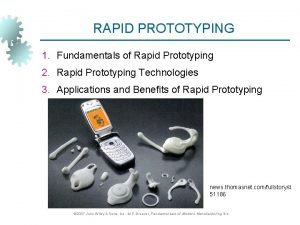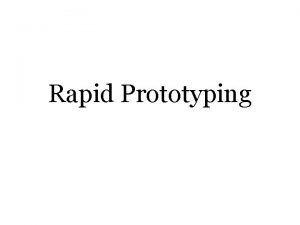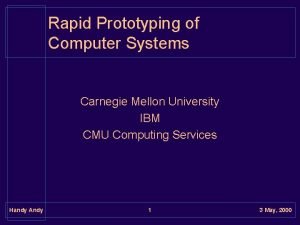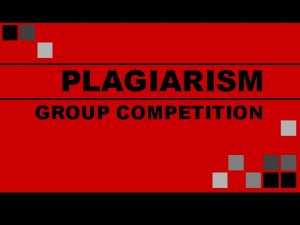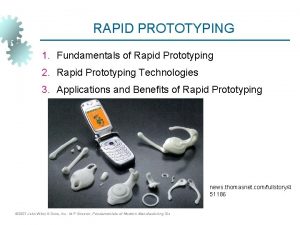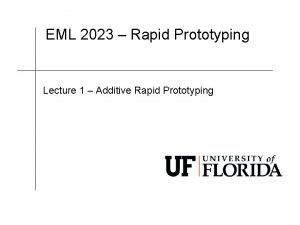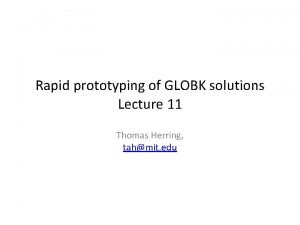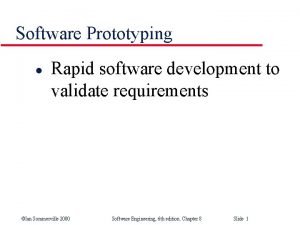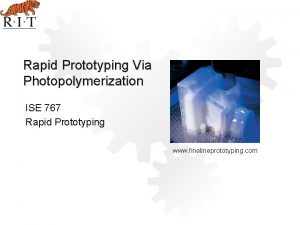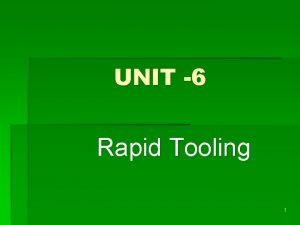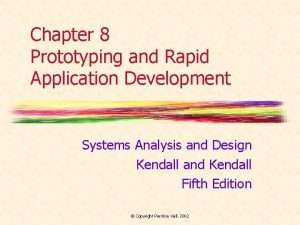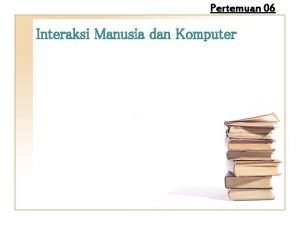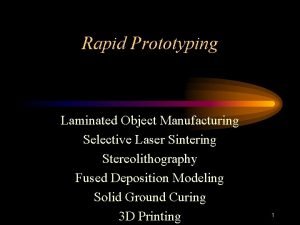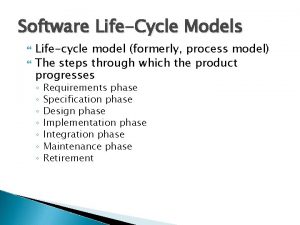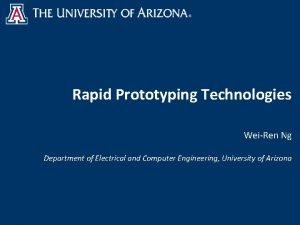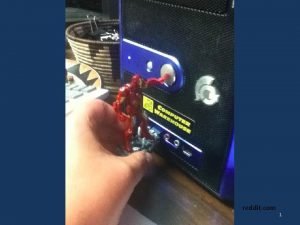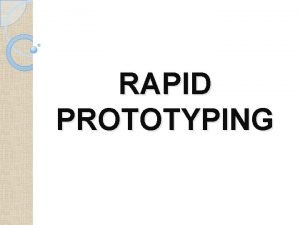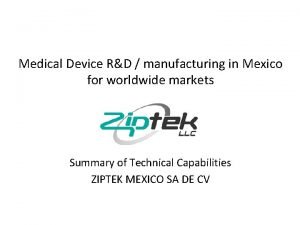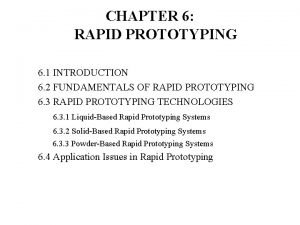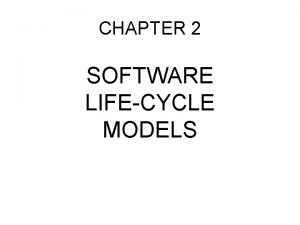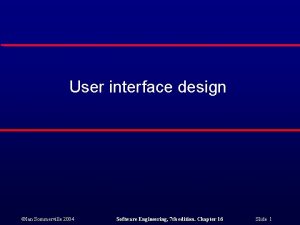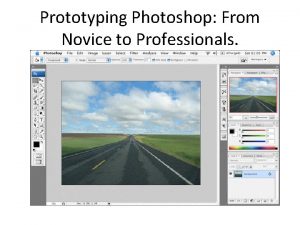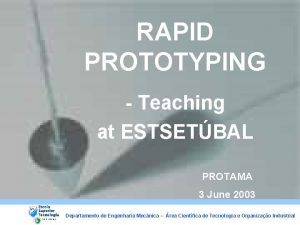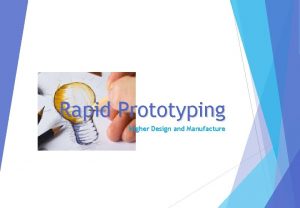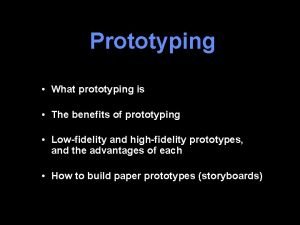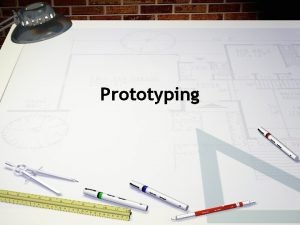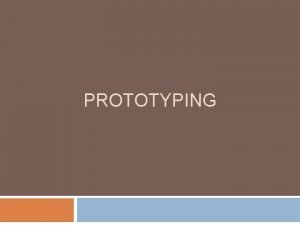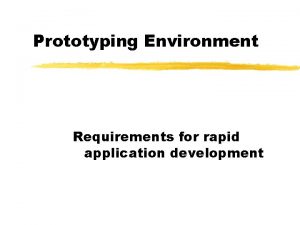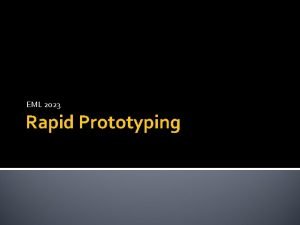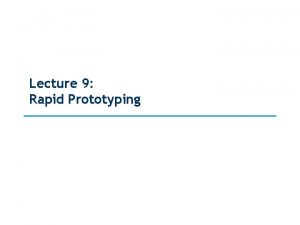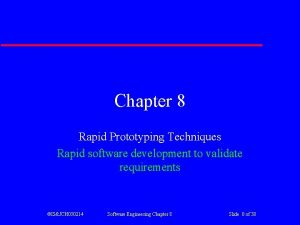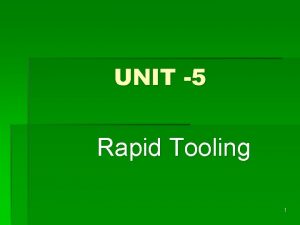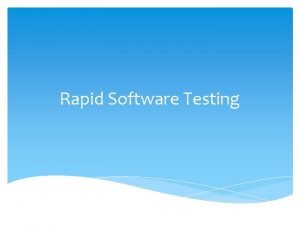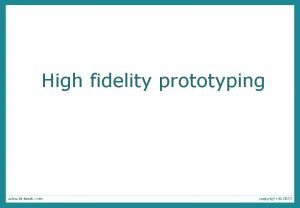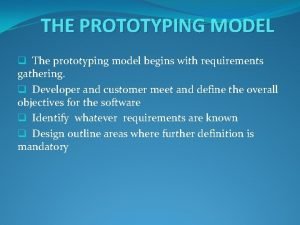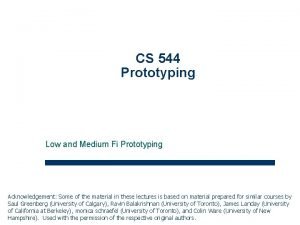RAPID PROTOTYPING 1 Fundamentals of Rapid Prototyping 2
























- Slides: 24

RAPID PROTOTYPING 1. Fundamentals of Rapid Prototyping 2. Rapid Prototyping Technologies 3. Applications and Benefits of Rapid Prototyping news. thomasnet. com/fullstory/4 51186 © 2007 John Wiley & Sons, Inc. M P Groover, Fundamentals of Modern Manufacturing 3/e

Rapid Prototyping (RP) A family of fabrication processes developed to make engineering prototypes in minimum lead time based on a CAD model of the item § Traditional method is machining § Can require significant lead-times – several weeks, depending on part complexity and difficulty in ordering materials § RP allows a part to be made in hours or days, given that a computer model of the part has been generated on a CAD system © 2007 John Wiley & Sons, Inc. M P Groover, Fundamentals of Modern Manufacturing 3/e

RP – Two Basic Categories: 1. Material removal RP - machining, using a dedicated CNC machine that is available to the design department on short notice § Starting material is often wax § Easy to machine § Can be melted and resolidified § The CNC machines are often small - called desktop machining 2. Material addition RP - adds layers of material one at a time to build the solid part from bottom to top © 2007 John Wiley & Sons, Inc. M P Groover, Fundamentals of Modern Manufacturing 3/e

Starting Materials in Material Addition RP 1. Liquid monomers that are cured layer by layer into solid polymers 2. Powders that are aggregated and bonded layer by layer 3. Solid sheets that are laminated to create the solid part Additional Methods § In addition to starting material, the various material addition RP technologies use different methods of building and adding layers to create the solid part § There is a correlation between starting material and part building techniques © 2007 John Wiley & Sons, Inc. M P Groover, Fundamentals of Modern Manufacturing 3/e

Steps to Prepare Control Instructions 1. Geometric modeling - model the component on a CAD system to define its enclosed volume 2. Tessellation of the geometric model - the CAD model is converted into a computerized format that approximates its surfaces by facets (triangles or polygons) 3. Slicing of the model into layers - computerized model is sliced into closely-spaced parallel horizontal layers © 2007 John Wiley & Sons, Inc. M P Groover, Fundamentals of Modern Manufacturing 3/e

Solid Model to Layers Figure 34. 1 Conversion of a solid model of an object into layers (only one layer is shown). © 2007 John Wiley & Sons, Inc. M P Groover, Fundamentals of Modern Manufacturing 3/e

Classification of RP Technologies § There are various ways to classify the RP techniques that have currently been developed § The RP classification used here is based on the form of the starting material: 1. Liquid-based 2. Solid-based 3. Powder-based © 2007 John Wiley & Sons, Inc. M P Groover, Fundamentals of Modern Manufacturing 3/e

Liquid-Based Rapid Prototyping Systems § Starting material is a liquid § About a dozen RP technologies are in this category § Includes the following processes: § Stereolithography § Solid ground curing § Droplet deposition manufacturing © 2007 John Wiley & Sons, Inc. M P Groover, Fundamentals of Modern Manufacturing 3/e

Stereolithography (STL) RP process for fabricating a solid plastic part out of a photosensitive liquid polymer using a directed laser beam to solidify the polymer § Part fabrication is accomplished as a series of layers - each layer is added onto the previous layer to gradually build the 3 -D geometry § The first addition RP technology - introduced 1988 by 3 D Systems Inc. based on the work of Charles Hull § More installations than any other RP method © 2007 John Wiley & Sons, Inc. M P Groover, Fundamentals of Modern Manufacturing 3/e

Stereolithography Figure 34. 2 Stereolithography: (1) at the start of the process, in which the initial layer is added to the platform; and (2) after several layers have been added so that the part geometry gradually takes form. © 2007 John Wiley & Sons, Inc. M P Groover, Fundamentals of Modern Manufacturing 3/e

Solid Ground Curing (SGC) Like stereolithography, SGC works by curing a photosensitive polymer layer by layer to create a solid model based on CAD geometric data § Instead of using a scanning laser beam to cure a given layer, the entire layer is exposed to a UV source through a mask above the liquid polymer § Hardening takes 2 to 3 s for each layer © 2007 John Wiley & Sons, Inc. M P Groover, Fundamentals of Modern Manufacturing 3/e

Solid Ground Curing Figure 34. 4 SGC steps for each layer: (1) mask preparation, (2) applying liquid photopolymer layer, (3) mask positioning and exposure of layer, (4) uncured polymer removed from surface, (5) wax filling, (6) milling for flatness and thickness. © 2007 John Wiley & Sons, Inc. M P Groover, Fundamentals of Modern Manufacturing 3/e

Facts about SGC § Sequence for each layer takes about 90 seconds § Time to produce a part by SGC is claimed to be about eight times faster than other RP systems § The solid cubic form created in SGC consists of solid polymer and wax § The wax provides support for fragile and overhanging features of the part during fabrication, but can be melted away later to leave the freestanding part © 2007 John Wiley & Sons, Inc. M P Groover, Fundamentals of Modern Manufacturing 3/e

Droplet Deposition Manufacturing (DDM) Starting material is melted and small droplets are shot by a nozzle onto previously formed layer § Droplets cold weld to surface to form a new layer § Deposition for each layer controlled by a moving x-y nozzle whose path is based on a cross section of a CAD geometric model that is sliced into layers § Work materials include wax and thermoplastics © 2007 John Wiley & Sons, Inc. M P Groover, Fundamentals of Modern Manufacturing 3/e

Solid-Based Rapid Prototyping Systems § Starting material is a solid § Solid-based RP systems include the following processes: § Laminated object manufacturing § Fused deposition modeling © 2007 John Wiley & Sons, Inc. M P Groover, Fundamentals of Modern Manufacturing 3/e

Laminated Object Manufacturing (LOM) Solid physical model made by stacking layers of sheet stock, each an outline of the cross-sectional shape of a CAD model that is sliced into layers § Starting sheet stock includes paper, plastic, cellulose, metals, or fiber-reinforced materials § The sheet is usually supplied with adhesive backing as rolls that are spooled between two reels § After cutting, excess material in the layer remains in place to support the part during building © 2007 John Wiley & Sons, Inc. M P Groover, Fundamentals of Modern Manufacturing 3/e

Laminated Object Manufacturing Figure 34. 5 Laminated object manufacturing. © 2007 John Wiley & Sons, Inc. M P Groover, Fundamentals of Modern Manufacturing 3/e

Powder-Based RP Systems § Starting material is a powder § Powder-based RP systems include the following: § Selective laser sintering § Three dimensional printing © 2007 John Wiley & Sons, Inc. M P Groover, Fundamentals of Modern Manufacturing 3/e

Selective Laser Sintering (SLS) Moving laser beam sinters heat‑fusible powders in areas corresponding to the CAD geometry model one layer at a time to build the solid part § After each layer is completed, a new layer of loose powders is spread across the surface § Layer by layer, the powders are gradually bonded by the laser beam into a solid mass that forms the 3 -D part geometry § In areas not sintered, the powders are loose and can be poured out of completed part © 2007 John Wiley & Sons, Inc. M P Groover, Fundamentals of Modern Manufacturing 3/e

Three Dimensional Printing (3 DP) Part is built layer-by-layer using an ink-jet printer to eject adhesive bonding material onto successive layers of powders § Binder is deposited in areas corresponding to the cross sections of part, as determined by slicing the CAD geometric model into layers § The binder holds the powders together to form the solid part, while the unbonded powders remain loose to be removed later § To further strengthen the part, a sintering step can be applied to bond the individual powders © 2007 John Wiley & Sons, Inc. M P Groover, Fundamentals of Modern Manufacturing 3/e

Three Dimensional Printing Figure 34. 6 Three dimensional printing: (1) powder layer is deposited, (2) ink-jet printing of areas that will become the part, and (3) piston is lowered for next layer (key: v = motion). © 2007 John Wiley & Sons, Inc. M P Groover, Fundamentals of Modern Manufacturing 3/e

RP Applications § Applications of rapid prototyping can be classified into three categories: 1. Design 2. Engineering analysis and planning 3. Tooling and manufacturing © 2007 John Wiley & Sons, Inc. M P Groover, Fundamentals of Modern Manufacturing 3/e

Design Applications § Designers are able to confirm their design by building a real physical model in minimum time using RP § Design benefits of RP: § Reduced lead times to produce prototypes § Improved ability to visualize part geometry § Early detection of design errors § Increased capability to compute mass properties © 2007 John Wiley & Sons, Inc. M P Groover, Fundamentals of Modern Manufacturing 3/e

Problems with Rapid Prototyping § Part accuracy: § Staircase appearance for a sloping part surface due to layering § Shrinkage and distortion of RP parts § Limited variety of materials in RP § Mechanical performance of the fabricated parts is limited by the materials that must be used in the RP process © 2007 John Wiley & Sons, Inc. M P Groover, Fundamentals of Modern Manufacturing 3/e
 Rapid prototyping classification
Rapid prototyping classification Rapid prototype definition
Rapid prototype definition Cmu rapid prototyping
Cmu rapid prototyping Rapid prototyping could be an advantageous methodology
Rapid prototyping could be an advantageous methodology Méduce
Méduce Powder based rapid prototyping
Powder based rapid prototyping Waterfall v model
Waterfall v model Eml laser wikipedia
Eml laser wikipedia Eml2023
Eml2023 Rapid prototyping
Rapid prototyping Rapid throwaway prototype
Rapid throwaway prototype Photopolymer
Photopolymer Rapid prototyping pro metal system
Rapid prototyping pro metal system Prototyping and rapid application development
Prototyping and rapid application development Bentuk awal contoh atau standar ukuran dari sebuah
Bentuk awal contoh atau standar ukuran dari sebuah Lom rapid prototyping
Lom rapid prototyping Fountain model in software engineering
Fountain model in software engineering Rapid prototyping
Rapid prototyping Paper prototyping video
Paper prototyping video Rp techniques
Rp techniques Mexico rapid prototyping
Mexico rapid prototyping Powder based rapid prototyping
Powder based rapid prototyping Prototyping model
Prototyping model User interface prototyping in software engineering
User interface prototyping in software engineering Photoshop prototyping
Photoshop prototyping
